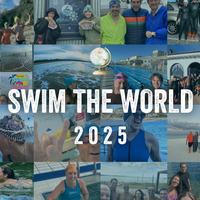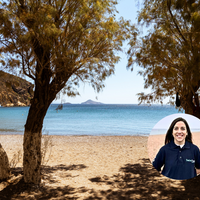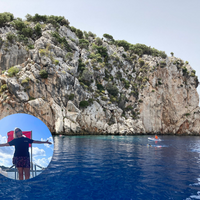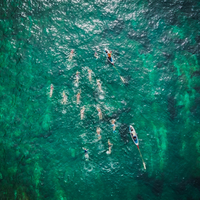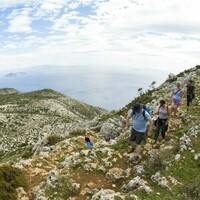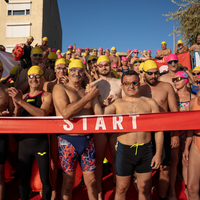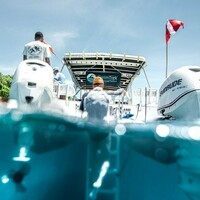We love taking indoor swimmers to the open water and helping them to #escapethepool. Outside of the pool, you’ll find so much more to stimulate your senses and engage your mind with. By taking on some of our essential open water tips, we’ll take you from newbie to flying fish! Here’s our roundup of the key areas you’ll need to acquaint yourself with when first transitioning into the open water.
Location
Open water swimming is swimming in a body of water that takes places outdoors and without man made constraints. FINA defines open water swimming as swimming taking place in either oceans, river or lakes, however, this definition can be expanded to ponds, wadis, natural pools, lagoons and waterfalls. Wherever there is open water, you’ll find passionate swimmers adoring it all over the world.
Open water is closely related to outdoor swimming, open air swimming and wild swimming, and each has their appeals. With open water swimming, we enjoy the freedom of the outdoors to swim in without any confinement, swimming in natural bodies of both fresh and saltwater.
We’re never confined to restricted swim spaces; we take in the fresh air and swim without limits. Open water swimming can be done all over the world, and SwimTrek loves to help bring people to swimming around the world too.
Temperature
You will find a variety of water temperatures both on our SwimTrek trips and in different open water swim spots around the world. You’ll find different water temperatures in seas compared to lakes, usually that sea water is warmer, and even in the same body of water at different times of the year.
Here’s our handy guide to the varying degrees of water temperatures, what to expect and how to prepare for swimming in them:
| Water temperature | What to expect |
|---|---|
| Above 26°C (79°F+) | Very warm open water temperatures that will usually be found around the Caribbean and, in height of summer, the Middle East and the warmest parts of the Mediterranean. Temperatures will be similar to that of a heated pool. Swimming in a wetsuit in these temperatures is not advised due to a risk of overheating. Make sure to drink frequently on your swim to prevent dehydration. |
| 22 – 25°C (72 – 77°F) | Ideal open water swimming temperatures, these are often found in the Mediterranean through the warmest summer months. Most swimmers will be comfortable without a wetsuit and able to swim for as long as they like without problems. |
| 17 – 21°C (63 – 70°F) | Pleasant swimming temperatures, the lower end of this category is usually the height of summer water temperatures in the UK. Some more susceptible to the cold may still want to wear a wetsuit. |
| 12 – 16°C (54 – 61°F) | These temperatures are usually found at the beginning and the end of the summer season. Comfortable skins swimming for longer periods of time is still possible for those acclimatised to slightly cooler waters. Swimming in sub 16-degree water is often a marker for qualifying times for channel swims and other distance events. |
| 6 – 11°C (43 – 52°F) | As we head into single digits, these are temperatures you’ll experience in the transition from autumn into winter. Most swimmers will need a wetsuit to be able to swim for even a short period of time, as well as gloves or a neoprene hat to help warm their extremities. |
| 1 – 5°C (34 – 41°F) | Very cold water. Sub 5 degrees is counted as ice swimming. Much shorter swim times are advised, keeping to less than 10-minute dips and only if you are acclimatised. |
| Below 0°C (Below 32°F) | For the truly brave, sub zero temperatures are rarely found and even a short dip should only be considered alongside extensive acclimatisation. |
The majority of SwimTrek’s trips enjoy water temperatures of above 17°C, excluding some of our training camps and expedition trips around the UK. If you are someone that particularly feels the cold, you may benefit from wearing a wetsuit on our trips.
Breathing
You may find that breathing in the open water will have to be different to how you would normally do so in the pool. Rougher conditions and the need to sight to see where you are some scenarios that may force you to adapt the way you breathe to the open water.
You should try to breathe bilaterally where possible, as this can greatly assist with your stroke. Breathing bilaterally helps to keep your body straight, something that can be harder to do in the open water without the guidance of a black line along the bottom of the swimming pool. Benefits of being able to do so include being able to anticipate potential hazards approaching from either side and being able to breathe on your left side, for example, if strong winds are coming from your right. When conditions are particularly choppy, you may find it beneficial to be able to keep your face in the water for longer and breathe less frequently to avoid getting a mouthful of water!
Sighting
Even for recreational swimmers, you need to be able to know where you are travelling to be able to swim efficiently and, most importantly, safely.
You’ll need to identify a landmark or an object in the water that won’t move considerably, like a swim buoy. Ideally, your landmark should be something that won’t be obstructed as you swim, by waves for example – something taller than a person and visible in different light conditions.
There are generally two approaches to sighting: either lift your whole head out of the water when looking ahead or to just lift your eyes above the surface of the water (like a crocodile). Both are considered fine to use in your swimming, so experiment with what feels most comfortable and natural to you.
When first attempting to incorporate sighting into your stroke, try to maintain a normal rhythm when it comes to breathing. It is important to remember that you want sighting to work for you and what feels comfortable to some swimmers may differ from others. The most popular technique is Crocodile eye sighting.
CROC EYES: When you first catch the water, reaching forward with one hand, push down on the surface to create stability and lift your eyes just above the water’s surface to sight. The goal is not to bring your head out of the water, but to bring your eyes out (like a crocodile) and then continue your stroke and breathe to the side as normal, repeating if necessary until you have sighted adequately.
HEAD LIFT: Alternatively, using the power from your pull, the aim is to bring your whole head out of the water to sight and breathe at the same time. The push down on the water from you pull will help surge you forward and up, giving the time to be able to take in the surroundings as well as taking a breath.
A longer article on our guide to sighting can be found at the Outdoor Swimming Society.
Conditions
As mentioned in the breathing and sighting sections, your conditions in the open water can vary considerably and may cause you to change your style of swimming in the water. Swimming in the open water in calm conditions can be very pleasant, but equally, swimming in wavier water can be very thrilling! It is useful to be aware of the following, more challenging weather conditions.
Swell – Simply put, swell is the naturally formed pattern of waves, often influenced by the geographical and geological location. These are not affected by the immediate local wind conditions, but are formed as wind-generated waves from the pattern of waves coming in from further afield.
Chop – Chop is the influenced by your surroundings, and can be created by buildings, boats and wind. You can experience chop on top of a swell and this can also be generated by local winds.
Rips currents – A rip current is a movement of water that starts parallel to the shore before washing back out towards the sea in a channel. They can be difficult to spot but if there are gaps in the incoming wave pattern (as it runs parallel to the shore), this can indicate rip currents. They can be very dangerous even to strong swimmers, carrying you further out from the coast and tiring you out. Common advice for escape a rip current is to swim parallel until you are out of the current, and then swimming vat an angle back towards the shore top avoid re-entering it.
The open water can feel daunting as you're just beginning. Getting in with the right attitude and making sure you take the steps to be safe and you'll be set to have an amazing experience! If you're looking for any further help with picking the best open water trip for you, get in touch with our customer team on email at info@swimtrek.com or by calling +44 (0)12379 739713.


